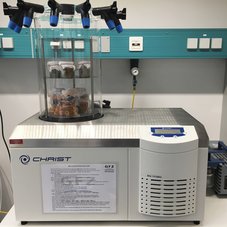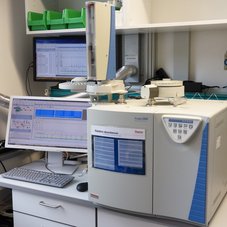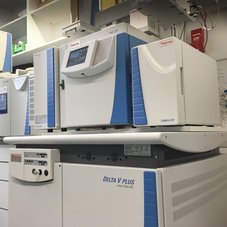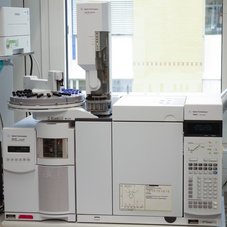Organic Surface Geochemistry Laboratory (OSGLab)

In the Organic Surface Geochemistry Lab (OSGLab) of the Geomorphology section the smallest of molecules and isotopes open a door to the past. In the OSGLab we conduct research on regional differences of the causes and effects of past climate change and variations in biochemical cycles. In some projects we can determine the 'traces' of climate change down to a decade, in other projects biogeochemical processes are traced over millions of years.
In the new laboratory, changes in the carbon cycle can be reconstructed from plants and microorganisms using so-called biomarkers. Biomarkers are resistant organic molecules that can be assigned to an organism. Their characteristic structures show which plant or algae produced them. Parts of plants enter lakes and oceans via soils and rivers and are deposited in sediments. Over the millennia, the plant parts decompose, but their biomarkers remain; they become molecular fossils, so to speak. We sample the sediments and analyse the biomarkers they contain in the laboratory.
Any inquiry about analytical possibilities and discussions of project ideas should be directed to O. Rach or D. Sachse.

Automated Solid Phase Extraction (aSPE)
The total liquid extract (TLE) obtained from the sample after solvent extraction is separated into several fractions of different component compositions by automated solid-phase extraction (SPE) using a solvent gradient of different polarity. The solid phase machine (Gilson ASPEC GX-271) can be equipped with 9 samples per run, which can be separated completely automatically into up to 5 different fractions. For the separation 6 ml standard glass columns filled with up to 5.5 ml silica gel are used. The columns can be rinsed with volumes of up to 20 ml of solvent. https://doi.org/10.1016/j.orggeochem.2020.103995

Accelerated Solvent Extraction (ASE)
The extraction of biomarkers from samples/sediments is done with an Accelerated Solvent Extraction (ASE 350, ThermoFisher). In order to ensure the most effective extraction with low solvent input and varying amounts of sediment or sample, extraction cells of various sizes are available (11-60 mL). The device can be equipped with a maximum of 24 extraction cells per run.

Freeze Dryer
The Lab is equipped with a freeze dryer (Christ Beta 1-8 LDplus). The machine has an ice condenser capacity of 8 kg, an ice condenser temperature of -55°C and is used to remove surplus water from samples which are in preparation for Biomarker analysis.

Elemental Analyzer coupled with a Delta-V Isotope Ratio Mass Spectrometer (EA-IRMS)
For quantitative carbon and nitrogen analysis on bulk samples, a Flash Elemental Analyzer 2000 (Flash EA 2000) from ThermoFisher Scientific equipped with a Thermal Conductivity Detector (TCD) is used in the laboratory. For measurements of stable carbon (δ13C) and nitrogen isotope ratios (δ15N) on bulk samples, the Flash EA 2000 is coupled with a Delta-V isotope ratio mass spectrometer. The measurement of stable hydrogen (δ2H) and oxygen isotope ratios (δ18O) on water samples can also be carried out with the Flash EA 2000, since the device is additionally equipped with a liquid autosampler. The Flash EA 2000 water analysis is primarily used for dirty and especially saline water samples.

Gas-Chromatograph coupled with a Delta-V Isotope Ratio Mass Spectrometer (GC-IRMS)
For the component-specific analysis of stable hydrogen (δ2H) and carbon isotope ratios (δ13C) on organic molecules, a ThermoFisher Scientific gas chromatograph (Trace 1310) coupled with a Delta-V isotope ratio mass spectrometer is available in the laboratory. The device is equipped with a TriPlus RSH autosampler for liquid and headspace injections as well as a heating reservoir for local derivatization. The autosampler's bottom-sense technology allows automated injection of samples with very low component concentrations.

Gas-Chromatograph with Flame Ionization Detector (FID) and Mass Selective Detector (GC-FID-MS)
For the quantification and identification of the organic substances, an Agilent gas chromatograph (GC 7890-A) with a flame ionization detector (FID) and a coupled single quadrupole mass spectrometer (MS 5975-C) is available in the laboratory. The device has an autosampler with 100 sample slots and can be equipped with various columns at short notice according to sample-specific requirements.

Picarro L-2140i Ringdown Spectrometer
The measurement of stable hydrogen (δ2H) and oxygen isotope ratios (δ18O and δ17O) on water samples is performed very efficiently in the laboratory with a Picarro L-2140i Ringdown spectrometer.

Semi-Preparative High Performance Liquid-Chromatograph with Mass Selective Detector (HPLC-MS)
For the identification, separation and quantification of complex organic molecules, a semi-preparative Agilent Infinity HPLC-MS (single-quadrupole) system with either an APCI (Atmospheric Pressure Chemical Ionization) or ESI (Electro-Spray-Ionization) source is available. Via a connected fraction collector, individual molecules can be collected and concentrated separately for further analysis.